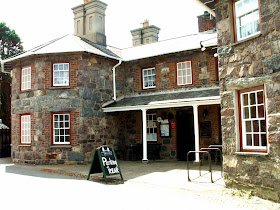The Randolph Turpin
The Randolph Turpin (Randy's Bar) is part of the Summit Complex, a former hotel at the top of The Great Orme at Llandudno. Randolph Turpin was a world boxing champion. He was born at Leamington Spa in 1928, the son of a man from Guyana who died when the boy was just 9 years old. Randy, as he was known, had to battle with colour prejudice and became a skilled boxer. He eventually notched up British and European middleweight titles but his moment of glory came when he defeated the renowned American world champion, Sugar Ray Robinson, to become world middleweight champion in 1951. Sadly he lost a re-match a few months later. Known as The Leamington Licker, he later became British and Commonwealth light-heavyweight champion. When he retired he became licensee of this pub but he seemed to be unable to cope with obscurity and missed the trappings of fame. He became bankrupt and in 1966 he committed suicide. He was just 37 years old. The bar is now completely renovated and themed on the boxer. Filled with pictures,posters and other boxing artifacts,and a large wooden statue of the man himself.
The sign on the village inn at
Beddgelert in North Wales reminds us how the village got its name.
Llewelyn was Prince of North
Wales back in the 13th century and he had a palace in a lovely
valley not far from Caernarfon. Legend
has it that one day the Prince went hunting leaving his faithful dog, Gelert,
to guard his baby son. When he returned
the dog, covered in blood, sprang to meet his master. The Prince was alarmed and when he found his
son’s cot empty with bloodstains everywhere he assumed that the dog had savaged
the child. He promptly killed the dog
with his sword. He then heard a child
crying and found the boy unharmed but nearby lay the body of a mighty wolf
which Gelert had slain. The Prince
buried the dog nearby and the village, near to the stone which marks the grave,
is called Beddgelert.
Gelert's grave
The Harp Hotel
The estate village of Llanwrog on
the Lleyn Peninsular in North Wales has a very fine stone built pub with two
octagonal towers and a nice porch over the entrance. On an old slate tablet attached to one of the
towers an inscription reads :
On level land, the finest inn,
with plenty of food and beer within,
and every hour of the day
the song birds, to make one gay.
on holidays and Sundays too
beware of drunkenness, be true.
enjoy your life, but don’t betray
the good old beer, come what may.
The Royal Oak
Above the doorway of the Royal Oak pub in the centre of
Fishguard in Wales are the words ‘Last
invasion of Britain peace treaty was signed here here in 1797.’
It refers to the last landing of a foreign army on British
soil which occurred during the Napoleonic Wars. In 1797 a force of 1,400 men
was put ashore at nearby Carregwastad Point with ambitious orders to march
north through Wales to take and burn the port of Liverpool. Half soldiers, half
released jail prisoners were under the
command of an Irish-American named Colonel Tate. They were immediately attacked
by a mixed force of yeomanry and villagers including women, and in two days
their surrender was accepted. The French invasion force was lined up on Goodwin
Sands and Colonel Tate signed a surrender document in the presence of British
commander Earl Cawdor at the Royal Oak. The table on which this took place can
be still seen inside the pub.
St Govan’s Inn
St Govan’s Inn at Bosherton on the Pembrokeshire coast of
south Wales reminds us about the legends surrounding St Govan. A short distance
from Bosherton there is a small crevice in the cliffs wherein there is the tiny
chapel of St Govan which can be reached down a steep flight of 52 steps. It is
said that the steps never count the same going up as going down. According to
legend, in the 6th century
hermit St Govan was being chased by pirates when the fissure miraculously
opened up to hide him and closed over him until the pirates has gone. St Govan
decided to build a cell at the spot and remained there for the rest of his life
preaching and teaching Christianity to the local people. Outside the chapel is
the Bell Rock and legend has it that a silver bell in the chapel bell tower was
stolen by pirates and when St Govan prayed for its return, it was placed inside
the rock by angels for safe keeping. St Govan used to tap the rock to produce a
sound a thousand times stronger than the original bell. There was also a well
near the chapel said to be a healing well.

St Govan's Chapel

To whom I am grateful for the use of his Geograph photograph
St Govan is said to have been buried under the chapel altar
when he died in 586.















No comments:
Post a Comment